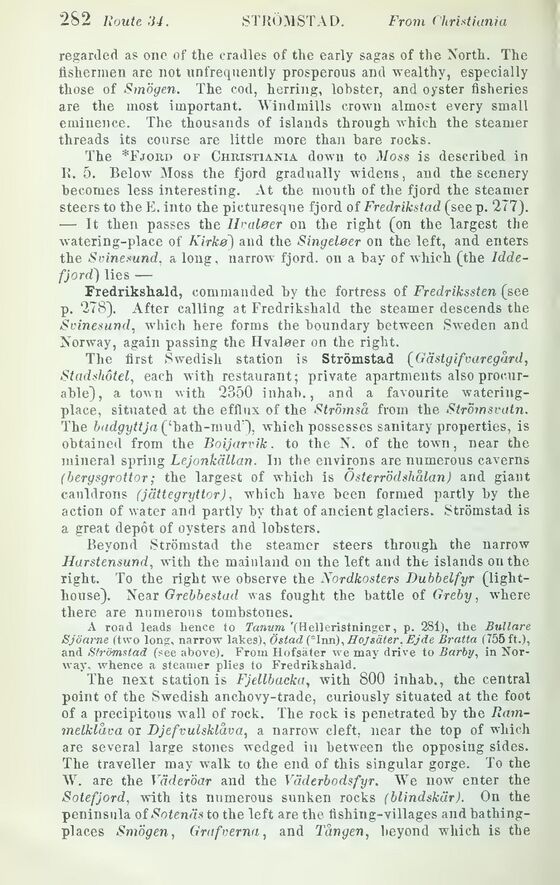
Full resolution (JPEG) - On this page / på denna sida - Sweden - Pages ...

<< prev. page << föreg. sida << >> nästa sida >> next page >>
Below is the raw OCR text
from the above scanned image.
Do you see an error? Proofread the page now!
Här nedan syns maskintolkade texten från faksimilbilden ovan.
Ser du något fel? Korrekturläs sidan nu!
This page has never been proofread. / Denna sida har aldrig korrekturlästs.
regarded as one of the cradles of the early sagas of the North. The
fishermen are not unfrequently prosperous and wealthy, especially
those of Smögen. The cod, herring, lobster, and oyster fisheries
are the most important. Windmills crown almost every small
eminence. The thousands of islands through which the steamer
threads its course are little more than bare rocks.
The *Fjord of Christiania down to Moss is described in
II. 5. Below Moss the fjord gradually widens, and the scenery
becomes less interesting. At the mouth of the fjord the steamer
steers to the E. into the picturesque fjord of Fredrikstad (see p. 277).
— It then passes the Hvaleer on the right (on the largest the
watering-place of Kirke] and the Singeleer on the left, and enters
the Svinesund, a long, narrow fjord, on a hay of which (the
Idde-fjord) lies —
Fredrikshald, commanded by the fortress of Fredrikssten (see
p. 278). After calling at Fredrikshald the steamer descends the
Svinesund, which here forms the boundary between Sweden and
Norway, again passing the Hvaleer on the right.
The first Swedish station is Strömstad (Gästgifvaregård,
Stadshötel, each with restaurant; private apartments also
procurable), a town with 2350 inhab., and a favourite
watering-place, situated at the efflux of the Strömså from the Strömsvatn.
The badgyttja(fhath-mud:). which possesses sanitary properties, is
obtained from the Boijarvik. to the N. of the town, near the
mineral spring Lejonkällan. In the environs are numerous caverns
(bergsgrottor; the largest of which is Osterrödshålan) and giant
cauldrons (jättegryttor), which have been formed partly by the
action of water and partly by that of ancient glaciers. Strömstad is
a great depot of oysters and lobsters.
Beyond Strömstad the steamer steers through the narrow
Harstensund, with the mainland on the left and the islands on the
right. To the right wre observe the Nordkosters Dubbelfyr
(lighthouse). Near Grebbestad was fought the battle of Greby, where
there are numerous tombstones.
A road leads hence to Tanum ’(Helleristninger, p. 281), the Bullare
Sjöarne (two long, narrow lakes), Östad ( Inn), Ilojsäler. Ejde Bralta (755 ft.),
and Strömstad (see above). From Hofsater we may drive to Barby, in
Norway, whence a steamer plies to Fredrikshald.
The next station is Fjellbacka, with 800 inhab., the central
point of the Swedish anchovy-trade, curiously situated at the foot
of a precipitous wall of rock. The rock is penetrated by the
Ram-melkluva or Djefvulsklava, a narrow cleft, near the top of which
are several large stones wedged in between the opposing sides.
The traveller may walk to the end of this singular gorge. To the
W. are the Väderöar and the Väderbodsfyr. We now enter the
Sotefjord, with its numerous sunken rocks (blindskär). On the
peninsula of So ten as to the left are the fishing-villages and
bathing-places Smögen, Graf verna, and Tangen, beyond which is the
<< prev. page << föreg. sida << >> nästa sida >> next page >>